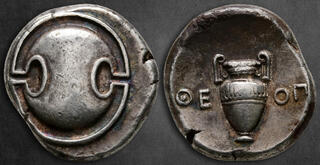| Savoca Numismatik GmbH & Co. KG > Online Auction 188 | Black | Auction date: 17 December 2023 |
| Lot number: 20 Price realized: 2,400 EUR (Approx. 2,639 USD) Note: Prices do not include buyer's fees. | Show similar lots on CoinArchives Find similar lots in upcoming auctions on |
| Lot description: Boeotia. Thebes circa 395-338 BC. ΘΕΟΠ- (Theop-), magistrate Stater AR 23 mm, 12,10 g Boeotian shield / ΘΕ-ΟΠ, volute krater with a decorated upper half, all within incuse concave circle. good very fine, lovely toned BCD (Triton IX, 2006, Lot 557); HGC 4, 1334. The Boeotian shield, also known as the aspis or hoplon, holds a distinctive place in ancient Greek military history, particularly during the classical period. Named after the region of Boeotia in central Greece, this shield was a fundamental piece of equipment for hoplites, the heavily armed infantry of ancient Greece. What sets the Boeotian shield apart is its unique convex shape. Unlike the more common round shields, the Boeotian shield featured a pronounced, almost hemispherical curvature. This design provided increased protection for the warrior, covering a larger portion of the body compared to flatter shields. The convex surface also made it more challenging for opponents to deliver a direct, penetrating blow. Crafted from wood, often reinforced with bronze or leather, the Boeotian shield exemplified the hoplite's commitment to both defense and offense. It typically bore the distinctive lambda (Λ) symbol, representing Lacedaemon, the region of Sparta, and showcasing the city-state's influence on Boeotian military tactics. During the Battle of Delium in 424 BCE, Boeotian hoplites equipped with their characteristic shields played a crucial role. The shields' design, coupled with the disciplined tactics of the Boeotian forces, contributed to the success of their phalanx formation. Starting price: 1 EUR |  |


